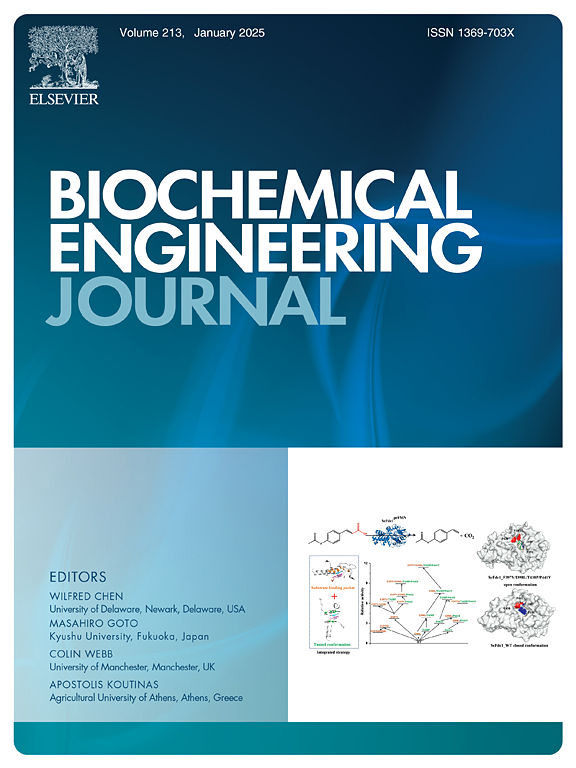Structural design of cellulose derivative-modified chitosan adsorbents for arsenic removal: Machine learning modeling, Box-Behnken design, Optuna hyperparameter tuning, and molecular dynamics
IF 3.7
3区 生物学
Q2 BIOTECHNOLOGY & APPLIED MICROBIOLOGY
引用次数: 0
Abstract
Heavy metal contamination poses significant environmental and public health risks, necessitating the development of effective remediation strategies. Although cellulose derivatives are widely used to modify adsorbents, hydroxypropyl cellulose (HPC) has not yet been investigated for functionalizing adsorbents in heavy metal removal. This study aimed to enhance As(III) adsorption performance by optimizing the structural properties of the hydroxypropyl cellulose-modified chitosan/polyvinyl alcohol (HPC/CP) adsorbent using the Box-Behnken design (BBD) and several machine learning (ML) algorithms. The optimization process focused on four key structural parameters: chitosan (CS) content, HPC content, polyvinyl alcohol (PVA) content, and the thickness of the adsorbent. The random forest (RF) ML algorithm confirmed the highest predictive accuracy (R² = 0.99, MSE = 2.31) after hyperparameter tuning (max_depth = 38, min_samples_leaf = 29, min_samples_split = 13, n_estimators = 470). The optimal adsorbent composition was identified as 5 wt% CS, 4 wt% HPC, 12 wt% PVA, and 300 µm thickness. The optimized adsorbent achieved an experimental As(III) removal efficiency of 98.6 %, significantly higher than the unoptimized adsorbent (65.3 %). The RF-predicted removal (96.1 %) closely aligned with experimental results and outperformed other ML models. Molecular dynamics simulations further validated the structural stability of the As(III)/HPC/CP complex through reduced energy fluctuations. HPC functionalization, combined with ML-driven optimization, significantly enhances the As(III) removal efficiency of CS-based adsorbents.
用于除砷的纤维素衍生物修饰壳聚糖吸附剂的结构设计:机器学习建模,Box-Behnken设计,Optuna超参数调整和分子动力学
重金属污染造成严重的环境和公众健康风险,需要制定有效的补救战略。虽然纤维素衍生物被广泛用于改性吸附剂,但羟丙基纤维素(HPC)在重金属去除中的功能化吸附剂尚未得到研究。本研究采用Box-Behnken设计(BBD)和几种机器学习(ML)算法优化羟丙基纤维素改性壳聚糖/聚乙烯醇(HPC/CP)吸附剂的结构性能,以提高对As(III)的吸附性能。优化过程主要围绕壳聚糖(CS)含量、HPC含量、聚乙烯醇(PVA)含量和吸附剂厚度四个关键结构参数进行。经过超参数调优(max_depth = 38, min_samples_leaf = 29, min_samples_split = 13, n_estimators = 470)后,随机森林(RF) ML算法的预测精度最高(R²= 0.99,MSE = 2.31)。最佳吸附剂组成为5 wt% CS, 4 wt% HPC, 12 wt% PVA,厚度300 µm。优化后的吸附剂对As(III)的实验去除率为98.6 %,显著高于未优化的吸附剂(65.3 %)。rf预测的去除率(96.1 %)与实验结果密切相关,优于其他ML模型。分子动力学模拟通过减小能量波动进一步验证了As(III)/HPC/CP配合物的结构稳定性。HPC功能化与ml驱动优化相结合,显著提高了cs基吸附剂对As(III)的去除效率。
本文章由计算机程序翻译,如有差异,请以英文原文为准。
求助全文
约1分钟内获得全文
求助全文
来源期刊

Biochemical Engineering Journal
工程技术-工程:化工
CiteScore
7.10
自引率
5.10%
发文量
380
审稿时长
34 days
期刊介绍:
The Biochemical Engineering Journal aims to promote progress in the crucial chemical engineering aspects of the development of biological processes associated with everything from raw materials preparation to product recovery relevant to industries as diverse as medical/healthcare, industrial biotechnology, and environmental biotechnology.
The Journal welcomes full length original research papers, short communications, and review papers* in the following research fields:
Biocatalysis (enzyme or microbial) and biotransformations, including immobilized biocatalyst preparation and kinetics
Biosensors and Biodevices including biofabrication and novel fuel cell development
Bioseparations including scale-up and protein refolding/renaturation
Environmental Bioengineering including bioconversion, bioremediation, and microbial fuel cells
Bioreactor Systems including characterization, optimization and scale-up
Bioresources and Biorefinery Engineering including biomass conversion, biofuels, bioenergy, and optimization
Industrial Biotechnology including specialty chemicals, platform chemicals and neutraceuticals
Biomaterials and Tissue Engineering including bioartificial organs, cell encapsulation, and controlled release
Cell Culture Engineering (plant, animal or insect cells) including viral vectors, monoclonal antibodies, recombinant proteins, vaccines, and secondary metabolites
Cell Therapies and Stem Cells including pluripotent, mesenchymal and hematopoietic stem cells; immunotherapies; tissue-specific differentiation; and cryopreservation
Metabolic Engineering, Systems and Synthetic Biology including OMICS, bioinformatics, in silico biology, and metabolic flux analysis
Protein Engineering including enzyme engineering and directed evolution.
 求助内容:
求助内容: 应助结果提醒方式:
应助结果提醒方式:


